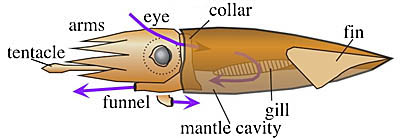Jet propulsion is the typical method of swimming fast in cephalopods. Other common methods of swimming involve the use of the fins, or the combination of arms and web (medusoid swimming).
During jet propulsion, water is taken into the mantle cavity by expansion of the mantle. Water enters laterally at the sides of the head, passes over the collar, over the gills and leaves through the funnel when the mantle contracts. Mantle contraction causes water pressure in the mantle cavity to increase and forces the collar against the mantle wall. The collar, therefore, acts as a one-way valve to prevents water from leaving by the same route that it entered. The ventral wall of the funnel presses against the mantle during mantle contraction and seals that opening as well. Water, therefore, is forced through the funnel and out the funnel orifice. The force provided by the water leaving the funnel can be directed by movements of the funnel. Typically the water leaves the funnel anteriorly causing the cephalopod to jet backward (e.g. when escaping a predator) or the funnel is directed posteriorly causing the water to leave posteriorly and the animal to jet anteriorly (e.g. when pouncing on a prey).
The method of inflating (or expanding) the mantle involves the contraction of radial muscles in the mantle wall which causes the wall to become thinner. Since the mantle wall is mostly muscle, its volume cannot change and the diamenter of the mantle, therefore, must increase. The result is that water is pulled into the mantle cavity. Contraction of the mantle involves the circular muscles that make up most of the muscle mass of the mantle.







 Go to quick links
Go to quick search
Go to navigation for this section of the ToL site
Go to detailed links for the ToL site
Go to quick links
Go to quick search
Go to navigation for this section of the ToL site
Go to detailed links for the ToL site